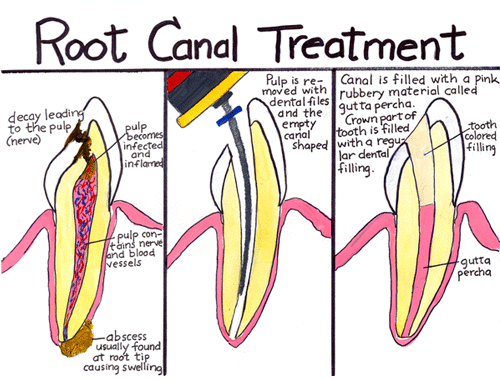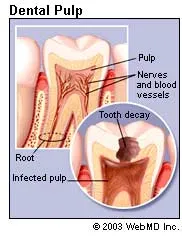An Overview of Root Canals

Root canal therapy is a treatment used to repair and save a tooth that is badly decayed or infected.
A root canal procedure is performed when the nerve of the tooth becomes infected or the pulp becomes damaged. During a root canal procedure, the nerve and pulp are removed, and the inside of the tooth is cleaned and sealed.
Root canal procedures have the reputation of being painful. Actually, most people report that the procedure itself is no more painful than having a filling placed. The discomfort experienced in the period leading up to seeking dental care is truly painful, not the root canal procedure itself.
What Is Dental Pulp?
 The pulp or pulp chamber is the soft area within the center of the tooth. The tooth’s nerve lies within root canals, which lie within the roots or “legs” of the tooth. The root canals travel from the tip of the tooth’s root into the pulp chamber, which also contains blood vessels and connective tissue that nourish the tooth.
The pulp or pulp chamber is the soft area within the center of the tooth. The tooth’s nerve lies within root canals, which lie within the roots or “legs” of the tooth. The root canals travel from the tip of the tooth’s root into the pulp chamber, which also contains blood vessels and connective tissue that nourish the tooth.
A tooth’s nerve is not vitally important to a tooth’s health and function after the tooth has emerged through the gums. Its only function is sensory — to provide the sensation of heat or cold. The presence or absence of a nerve will not affect the day-to-day functioning of the tooth.
Why Does the Pulp Need to Be Removed?
When nerve tissue or pulp is damaged, it breaks down, and bacteria begin to multiply within the pulp chamber. The bacteria and other decayed debris can cause an infection or abscessed tooth. An abscess is a pus-filled pocket that forms at the end of a tooth’s root. In addition to an abscess, an infection in the root canal of a tooth can cause:
- Swelling that may spread to other areas of the face, neck, or head
- Bone loss around the tip of the root
- Drainage problems extending outward from the root. A hole can occur through the side of the tooth, with drainage into the gums or through the cheek into the skin.
What Damages a Tooth’s Nerve and Pulp in the First Place?
A tooth’s nerve and pulp can become irritated, inflamed, and infected due to deep decay, repeated dental procedures on a tooth, large fillings, a crack or chip in the tooth, or trauma to the face.
What Are the Signs That Root Canal Therapy Is Needed?
Signs you may need root canal therapy include:
- Severe toothache pain upon chewing or application of pressure
- Prolonged sensitivity (pain) to hot or cold temperatures (after the heat or cold has been removed)
- Discoloration (darkening) of the tooth
- Swelling and tenderness in nearby gums
- A persistent or recurring pimple on the gums
Sometimes no symptoms are present.




